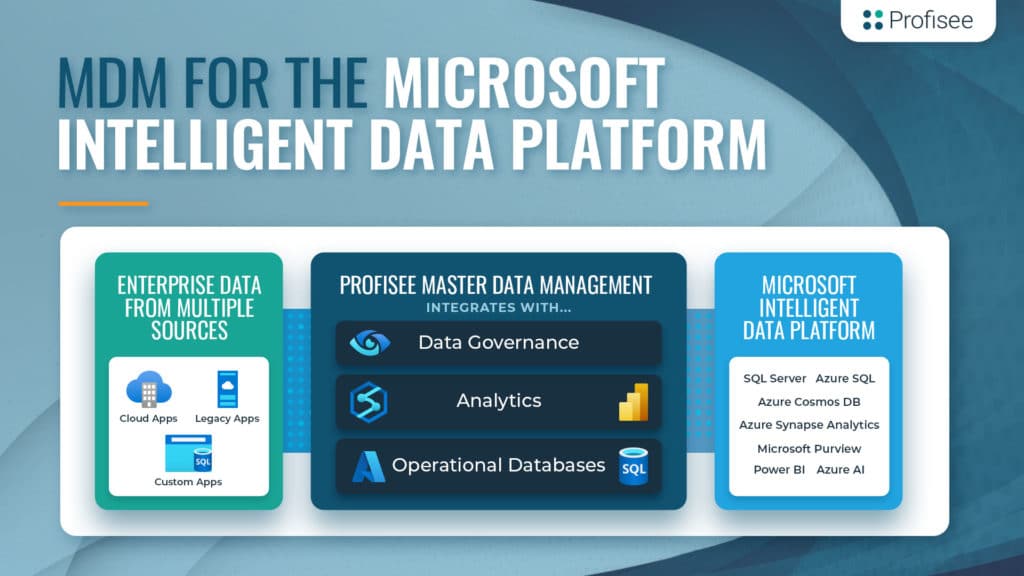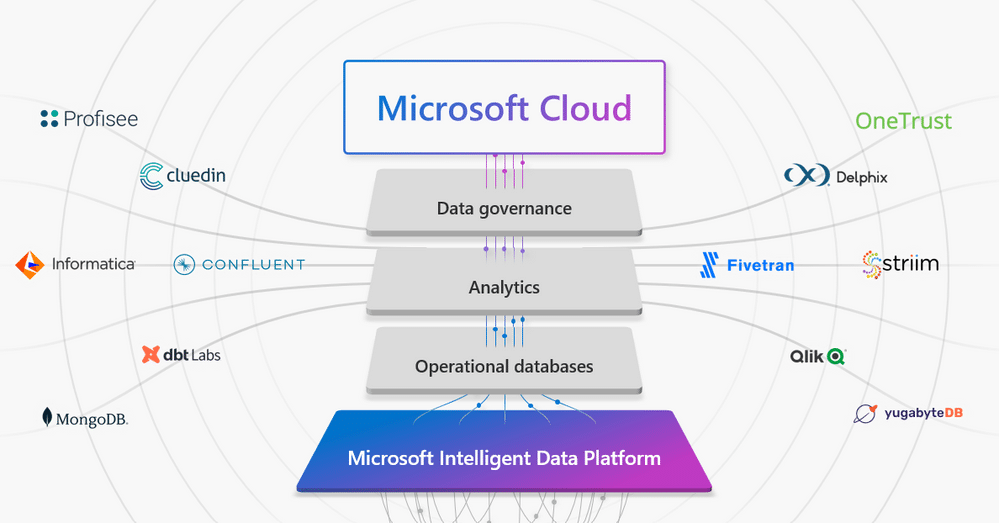Microsoft Intelligent Data Platform – What, Why, How & Who [2023]


Table of Contents
- What is the Microsoft Intelligent Data Platform
- Why Do I Need the Microsoft Intelligent Data Platform?
- How Do I Leverage the Microsoft Intelligent Data Platform?
- Who Should Be Involved with the Microsoft Intelligent Data Platform?
- Bring the Microsoft Intelligent Data Platform to Your Business Download Guide
Updated: September 6, 2023
Many organizations are pursuing the cloud to integrate and manage their enterprise data. By addressing the fragmentation that exists within their data estate, businesses can accelerate agility and innovation.
And to help more customers optimize their data landscape, Microsoft announced the Microsoft Intelligent Data Platform, an integrated, open cloud platform that encompasses their data governance, analytics and database ecosystems across the entire Microsoft landscape.
Download your exclusive copy of the guide to keep in your back pocket. Or if you’re ready to dive in, continue your journey below.
WHAT YOU’LL LEARN FROM THIS ARTICLE:
This article explains what the Microsoft Intelligent Data Platform is, why it is important, how to manage it and who should be involved — while identifying the key components of the Microsoft and Azure ecosystems and how you can best leverage them.
Let’s get started!
What is the Microsoft Intelligent Data Platform
Microsoft’s Corporate Vice President of Azure Data announced the Microsoft Intelligent Data Platform in May 2022 “to help address the fragmentation that exists today between databases, analytics and governance, and enable organizations to unlock these new capabilities.”
The Microsoft Intelligent Data Platform was developed to help their customers become more agile so they could adapt to market and technological challenges in real-time, add layers of intelligence to their applications, unlock predictive insights and govern their data — regardless of where it is stored.
Which Services are Included in the Microsoft Intelligent Data Platform?
The Microsoft Intelligent Data Platform encompasses Microsoft’s databases, analytics and governance tools across Azure, Microsoft Security, Dynamics 365 and more.| Databases | Analytics | Data Governance |
|---|---|---|
| Azure SQL: Provides options for migration, modernization and development | Azure Synapse Analytics: Learn how to navigate the Azure portal | Microsoft Purview: Standardize your data to maximize its business value |
| Azure Cosmos DB: Allows you to build or update high-performance apps with a NoSQL database service Power BI and Microsoft Azure together: Combine the two to harmonize your data estate | Azure Cosmos DB: Allows you to build or update high-performance apps with a NoSQL database service Power BI and Microsoft Azure together: Combine the two to harmonize your data estate | |
| Azure Synapse Link for Azure Cosmos DB: Receive real-time insights from operational data | Machine Learning for Data Scientists: Build cloud-scale solutions with machine-learning tools | |
| Azure Synapse Link for SQL: Transport data without lengthy extract, transform and load (ETL) processes | Azure Databricks: Openly utilize analytics and machine learning with a secure foundation | |
| Hybrid and Multi-cloud Solutions: Access on-premises, multi-cloud and edge environments anywhere | ||
| SQL Server 2022: Innovate and perform across performance, security and availability | ||
| SQL Developer Tools: Access tools and APIs for your platform to quickly develop intelligent apps |
What is the Microsoft Intelligent Data Platform Partner Ecosystem?
Following the initial launch announcement in May 2022, Microsoft announced the new Microsoft Intelligent Data Platform Partner Ecosystem in October 2022.
According to Microsoft, the Microsoft Intelligent Data Platform is the natural choice for independent software vendor (ISV) partners to build and deliver integrated solutions through an open and governed foundation.
The partner ecosystem enables customers across all industries to take advantage of the Microsoft Intelligent Data Platform capabilities, including a seamless, enriched, and cost-optimized experience that meets their specific needs.
The initial set of ISV partners aligned with the Microsoft Intelligent Data Platform partner ecosystem at launch include:

Microsoft Purview
While originally released as Azure Purview in September 2021, it was rebranded as Microsoft Purview in April 2022.
The newer release served as a step up from the previous iteration bringing together former Azure Purview and Microsoft 365 Compliance portfolio functionalities under a single brand to create a more unified platform for end users.
According to Microsoft, Microsoft Purview helps businesses understand and govern the data across their entire estate, safeguard that data wherever it lives, and improve the risk and compliance posture in a much simpler way than traditional solutions.
Microsoft Purview gives organizations a a unified data governance solution. By summarizing your data estate, it delivers key insights on stewardship and governance while also pointing out the possible risks involved with your foundational data. Purview allows data leaders to govern and administer their on-premises, multi-cloud and software-as-a-service (SaaS) data while also having a better understanding of their overall data estate.
Microsoft Purview performs several core features including:
- Audit
Support forensic investigations and meet regulatory requirements with critical audit log events, and customized retention policies.
- Communication Compliance
Foster a safe and compliant workplace by detecting sensitive or inappropriate content shared across your organization’s communication channels.
- Compliance Manager
Reduce risk by translating complex regulatory requirements into specific improvement actions that help you raise your score and track progress.
- Data Lifecycle Management
Classify and govern data at scale to meet your legal, business, privacy, and regulatory content obligations.
- Data Loss Prevention
Automatically protect sensitive information from risky and unauthorized access across apps, services, endpoints, and on-premises files.
- Data Map and Data Catalog
Maximize the business value of data for your consumers by creating a unified map to automate and manage metadata from hybrid sources. Make data easily discoverable and understand the origin of your data with interactive data lineage visualization.
- eDiscovery
Discover and manage your data in-place with end-to-end workflows for internal or legal investigations.
- Information Protection
Discover, identify, classify, and protect sensitive data that is business critical, then manage and protect it across your environment.
- Insider Risk Management
Detect, investigate, and take action on critical risks in your organization, including data theft, data leaks, and security policy violations.
Microsoft Purview manages all of your enterprise data by bringing governance and compliance products together under a single umbrella.
Azure Data Factory
The original version of Azure Data Factory (ADF) was released to the public in August 2015 with an upgraded version hitting public preview in June 2018.
According to Microsoft, Azure Data Factory is a fully managed, serverless data integration service with more than 90 built-in, maintenance-free connectors. From there, it enables you to deliver this integrated data to Azure Synapse Analytics to optimize results for reporting and analytics and leverage business insights.
Azure Data Factory provides cloud-based data integration while allowing you to create workflows for managing and orchestrating data movement and transformation. By enabling you to automate data movement between supported data stores, ADF ensures that your enterprise remains data-driven during every necessary data migration.
Azure Synapse
While initially announced at Microsoft Ignite in November 2019, Azure Synapse Analytics was made generally available in December 2020.
According to Microsoft, Azure Synapse Analytics is a limitless analytics service that brings together data integration, enterprise data warehousing and big data analytics. This enables users to query data on their terms with serverless or dedicated options. MIDP users are then provided with the option to land this operational data and provide it with dedicated SQL pools through the Azure Synapse Link for SQL.
Azure Synapse Link for SQL automatically transports your critical enterprise data from these databases and applications promptly while taking the workload for you. The integrative link offers you real-time analytics on your Azure-stored data and replicates data from your transactional SQL databases moving this over to an SQL pool in Azure Synapse Analytics. With minimal impact on your source systems, you can finally benefit from near real-time analytics while replicating important data with a low-code/no-code solution.
With Synapse, data can finally be replicated with full consistency.
Power BI
While initially referred to as Project Crescent during its 2011 release, Microsoft provided it with additional features such as Questions and Answers, enterprise-level data connectivity and more before it was rebranded to the public in 2015 as Power BI.
According to Microsoft, it is a unified, scalable platform for self-service and enterprise business intelligence (BI) allowing users to connect and visualize any data, and seamlessly infuse the visuals into their daily apps.
Power BI is interactive software that allows you to fully visualize, analyze and realize your data estate and the potential value that it can bring. It serves as a key part of the Microsoft Power Platform with a primary focus on business intelligence (BI). With the Microsoft Intelligent Data Platform also comes a premium self-service capability for Power BI called Datamart.
Datamart enables you to see actionable insights throughout each set of enterprise data. Developers and analysts can centrally govern and manage their workload(s) while saving time on pulling insights and easing the need and demand for IT assistance. Using Power BI, you can drive your organization’s digital transformation at every level with simplified data warehousing capabilities.
Azure Databricks
Before developing a relationship with Microsoft, Databricks began as a software company founded by the creators of Apache Spark in 2013 with the intent of developing a web-based platform for working with Spark. After launching as a first-party service on Microsoft Azure in November 2017, Azure Databricks remains an integral component for Microsoft’s machine learning capabilities and data science use cases.
Azure Databricks enables data-centric users to design AI and machine learning (ML) solutions with analytics based on Apache Spark. The service offers large-scale data processing, updated analytics and simplified/accelerated data science all rooted in a fast, open-source environment.
Azure SQL
Originally announced in 2009 and released the following year, Azure SQL serves as Microsoft’s premier managed cloud database. It was first updated in 2014 before sharing the SQL Server 2016 codebase.
According to Microsoft, the database allows customers to migrate, modernize and innovate on the modern SQL family of cloud databases while providing a unified experience across an entire SQL portfolio with a full range of deployment options from edge to cloud.
Azure SQL is a fully managed platform as a service (PaaS) database engine that automatically handles several functions including upgrading, patching, backups and monitoring without relying on action from the user. It is always running on the current SQL Server database engine and patched OS. Its built-in PaaS capabilities allow users to focus on domain-specific administration and optimization actions that are crucial for data-driven organizations.
SQL Server 2022
Recently released in November 2022, Microsoft’s latest cloud server includes many new and useful features highlighting by fully managed disaster recovery allowing users to replicate data both to and from the cloud.
According to Microsoft, the SQL Server 2022 is their most Azure-enabled release yet with continued performance, security and availability innovation. Key capabilities include:
- Business continuity through Azure
- Seamless analytics over on-prem operational data
- Visibility over an entire data estate
- The most secure database in the past decade
- Industry-leading performance and availability
It also includes hybrid capabilities with pay-as-you-go pricing. In order to provide a streamlined management experience, it manages the user’s SQL Server estate from the Azure portal. It is a key component for organizations to manage and govern their entire data estate with secure and trusted data.
Why Do I Need the Microsoft Intelligent Data Platform?
The Microsoft Intelligent Data Platform is built to enhance the value of enterprise data so that organizations can focus on enhancing the value of their business. By integrating databases, analytics and data governance together into a comprehensive ecosystem, the platform further delivers leading, cloud-native data and AI solutions to set customers up for success in diverse scenarios and situations. With this comes several benefits for business users and ISV partners including:- Seamless Database Integration – With leading databases MongoDB and Yugabyte working in tandem, enterprise data integration is enabled enhancing both analytics and ML/AI to govern data estates.
- Enriched Reporting and Analytics – Easily builds and operates complex pipelines governed in Microsoft Purview for data integration and transformation.
- Optimized Costs – By seamlessly integrating with the broader data estate throughout an entire enterprise, users and partners can scale their overall use and how it ultimately impacts their organization to align with established budgetary and financial expectations.
With the platform’s open and governed foundation, now enterprises can deliver integrated solutions with multiple tools working together under one cohesive ecosystem.
Operational Benefits of the Microsoft Intelligent Data Platform
The Microsoft Intelligent Data Platform enables you to manage your organization and satisfy consumer needs with a unified and trusted platform for your enterprise’s most critical data. The Microsoft Intelligent Data Platform was built on three foundational pillars:- Accelerating Innovation As a leading cloud data platform, the Microsoft Intelligent Data Platform aims to fully integrate databases, analytics and data governance in a single ecosystem. This seamless data platform empowers organizations to invest more time creating value rather than integrating and managing their enterprise data estate. Microsoft also announced enhancements and functional improvements to Azure Synapse Analytics, SQL Server 2022 and Azure SQL database to better integrate these applications and databases. For example, Azure Synapse Link for SQL removes data movement barriers, providing a seamless data pipeline to Azure Synapse Analytics, and enables near-real-time analytics for SQL Server 2022 and Azure SQL Database — enabling advanced analytics with no performance impact on transactional workloads. Once Azure Synapse Link transfers data to Azure Synapse Analytics, data can be used for advanced analytics with no performance impact on transactional workloads. Over 10 million Azure SQL databases globally can now leverage this capability.
- Achieving Agility Microsoft also announced additional improvements in performance, security and availability for SQL Server 2022, including the ability for customers to run the most demanding mission-critical workloads in hybrid and multi-cloud environments.Additionally, The Azure Database for MySQL Flexible Server Memory-Optimized service now features a 1.5x performance improvement over Single Server with faster failover time to standby. Azure Synapse Analytics also saw several improvements, including the ability to export Microsoft 365 (formerly Office 365) data directly into Azure. And finally, Microsoft announced the preview of a datamart in Power BI, a new Power BI Premium self-service capability that enables users to uncover actionable insights through their own datasets.
- Built on a Trusted Platform Tying all of the other facets of the Microsoft Intelligent Data Platform is a renewed commitment to enterprise data governance with enhancements to Microsoft Purview, including the public preview of Dynamic Lineage for Azure SQL Databases in Microsoft Purview. This allows Purview customers to further enrich the Microsoft Purview Data Map with details from actual runs of SQL stored procedures in Azure SQL Databases for customers to govern their data across hybrid and multi-cloud environments.
How Do I Leverage the Microsoft Intelligent Data Platform?
The Microsoft Intelligent Data Platform provides organizations with full control over their enterprise data. By reducing time spent on data management, standardization and maintenance through unified databases, analytics and governance functionalities, businesses can approach their data from every angle and leverage it to their advantage with each of its unique components.
MIDP is available commercially and is comprised of its individual components. These include:
- Microsoft Purview – Available in Azure/SQL databases in addition to MongoDB and Snowflake among others to classify and govern critical data.
- Azure Synapse Analytics – Comes with Microsoft’s Azure cloud platform and simplifies the reporting and analytics process.
- Power BI – Consists of several elements working together including the Power BI Desktop application, the online SaaS service called the Power BI service and the Power BI Mobile apps. This plug-and-play integration provides analytics users with fast and easy access to data directly.
- Azure Data Factory – While also included with Azure, it migrates and integrates your data into Synapse Analytics.
Who Should Be Involved with the Microsoft Intelligent Data Platform?
The Microsoft Intelligent Data Platform benefits developers and business analysts aiming to efficiently engage with customers while building their organization on a trustworthy data foundation. Now, independent software vendor (ISV) partners can deliver integrated solutions built on a trusted and governed platform.
The Azure-enabled platform seamlessly connects SQL server to Azure allowing developers to grow their business on their terms. It helps drive the Microsoft-powered systems, applications and initiatives you already have that play an integral role in your business and data strategies.
The MIDP can provide significant benefits to stakeholders throughout an organization, including:
Manufacturing / Operations Managers
Benefits of the Microsoft Intelligent Data Platform
Assists in navigating supply chain issues and disruptions by accurately predicting market shifts through real-time updates on current inventory levels and consumer demand.
Chief Data Officers (CDOs)
Benefits of the Microsoft Intelligent Data Platform
Chief Data Officers (CDOs) Eliminates siloed data and operating models and breaks down the fragmentation between databases, analytics and governance to improve data sharing and democratization while helping to launch strategic initiatives that drive revenue thus treating data as an asset.
Independent Software Vendor (ISV) Partners
Benefits of the Microsoft Intelligent Data Platform
Builds and delivers integrated solutions through an open and governed foundation of trusted data; benefits a wider range of customers through partner outreach with a data solution that meets customers’ specific needs.
Developers/Business Analysts
Benefits of the Microsoft Intelligent Data Platform
Allows creation of datamarts that can be centrally governed and managed to accelerate insight while alleviating IT demands.
Database Administrators (DBAs)
Benefits of the Microsoft Intelligent Data Platform
Features such as Cognos or Azure SQL provide faster access while interfacing with more types of data.
Data Governance Council / Owners
Benefits of the Microsoft Intelligent Data Platform
Microsoft Purview makes business glossary and metadata easily accessible and allows them to officially “certify” their data.
Bring the Microsoft Intelligent Data Platform to Your Business
The Microsoft Intelligent Data Platform creates performance benefits across your entire organization centered around cost reduction, speed of ingest, digital transformation and data source agility. Bring the platform’s AI capabilities to your data estate and gain deeper insights into both your business and customers more than ever before.
Interested in learning more about how the Microsoft Intelligent Data Platform and Profisee can maximize the value of your enterprise data? Download The Complete Guide to MDM & Governance for the Microsoft Intelligent Data Platform today.

Benjamin Bourgeois
Ben Bourgeois is the Head of Product and Customer Marketing at Profisee, where he leads the strategy for market positioning, messaging and go-to-market execution. He oversees a team of senior product marketing leaders responsible for competitive intelligence, analyst relations, sales enablement and product launches. He has experience managing teams across the B2B SaaS, healthcare, global energy and manufacturing industries.









